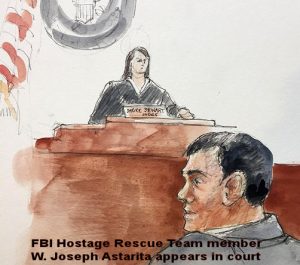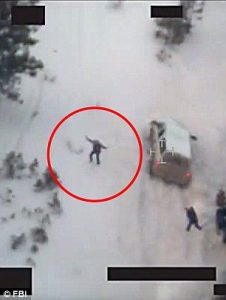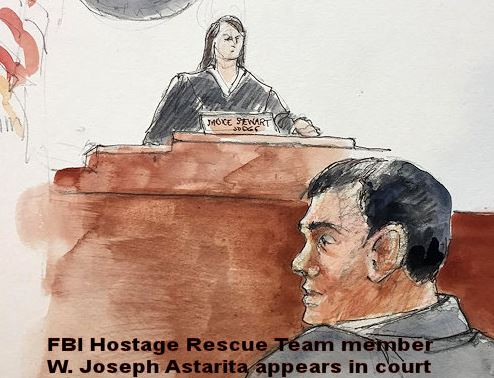First published in Range magazine
 It has now been almost three years since the infamous occupation of the Malheur National Wildlife Refuge in Harney County Ore., as part of a protest of the federal government’s mistreatment of Dwight and Steven Hammond. That standoff started on January 2, 2016 and ultimately resulted in the law enforcement shooting death of Arizona rancher LaVoy Finicum on January 26, 2016. At this point, following multiple criminal trials, his death was recently described as merely a footnote on the whole sordid affair.
It has now been almost three years since the infamous occupation of the Malheur National Wildlife Refuge in Harney County Ore., as part of a protest of the federal government’s mistreatment of Dwight and Steven Hammond. That standoff started on January 2, 2016 and ultimately resulted in the law enforcement shooting death of Arizona rancher LaVoy Finicum on January 26, 2016. At this point, following multiple criminal trials, his death was recently described as merely a footnote on the whole sordid affair.

Loose-ends
According to the primary state investigation into the stop and Finicum’s resulting death, a total of eight lethal rounds were fired that day. That doesn’t even begin to account for what may have been dozens, if not hundreds, of rubber bullets that were fired, as well as flash bangs and smoke grenades, that were used to terrorize the occupants of Finicum’s truck, as the cops sought to provoke a bigger shoot-out. But according to the official investigation report, six of the lethal rounds fired that day were tied to Oregon State Police (OSP) officers, with just one trigger-happy officer firing five of those six. But two of the lethal rounds fired remained unaccounted for.
State investigators ultimately concluded that one agent with the FBI’s elite Hostage Rescue Team had fired the other two shots, and that both that agent and the whole team had lied about it, and tried to cover up their actions.
The FBI conducted its own internal investigation, which few thought would go anywhere. So it came as a quite a surprise when the U.S. Attorney for Oregon announced that he had secured indictments against FBI agent Joseph Astarita for obstruction of justice and lying to federal investigators.
 The Trial
The Trial
The Department of Justice made a big show of it at the trial in Portland in the Summer of 2018. The end result, however, was grim. Agent Astarita was acquitted on all counts, based on what appeared to be government’s intentional failure to meet its burden of proving beyond a reasonable doubt that he had fired any shots, and therefore failing to prove that he had lied about the shots or tried to cover them up.
That trial left more questions than answers. The end result looked like a carefully orchestrated ruse to clear the FBI of any and all wrongdoing and hang the whole affair neatly around the neck of Oregon Gov. Kate Brown and the Oregon state cops.
Astarita’s attorneys insisted that the government had failed to meet its burden of proof (which was hard to deny), and suggested that just one over-the-top state cop may have been responsible for all but one of the eight lethal rounds that were fired at Lavoy Finicum that day.
Where Things Stand at this Point
The LaVoy Finicum wrongful death case is far from over. Several indisputable facts remain: Despite the complete lack of probable cause, including any warrants for their arrest, Gov. Brown insisted that the federal government and FBI step in and intervene at the Malheur protest to stop such dangerous criminals from continuing to occupy the wildlife refuge on one hand, and from coming, going and traveling freely on the other.
In response to the governor’s insistence, the FBI coordinated with OSP to set up a warrantless kill-stop roadblock, after which the government attempted to claim that it was a so-called “felony stop.” But there were no warrants and no probable cause for any of it.
 When Finicum was confronted with a second “hard” roadblock on a blind curve, he only had two choices: either ram the blockade, or run into a deep snowbank. As lethal rounds were coming through his windshield, he chose the latter. With his truck grinding to a stop in the deep snow and more lethal rounds shattering a side window Finicum quickly exited, trying to draw fire away from the vehicle. As he floundered in the deep snow with his hands in the air, he may have been intentionally shot by a rubber bullet, which caused arguable “furtive” movements, followed by three lethal rounds to the back, which quickly brought him down. But all officers had been ordered to turn-off all dash-cams and body-cams.
When Finicum was confronted with a second “hard” roadblock on a blind curve, he only had two choices: either ram the blockade, or run into a deep snowbank. As lethal rounds were coming through his windshield, he chose the latter. With his truck grinding to a stop in the deep snow and more lethal rounds shattering a side window Finicum quickly exited, trying to draw fire away from the vehicle. As he floundered in the deep snow with his hands in the air, he may have been intentionally shot by a rubber bullet, which caused arguable “furtive” movements, followed by three lethal rounds to the back, which quickly brought him down. But all officers had been ordered to turn-off all dash-cams and body-cams.
Presumably, there will be one last trial—a civil, wrongful death case regarding actual accountability for LaVoy’s death, in which there will be a lower, preponderance-of-evidence burden of proof. The Ninth Federal Circuit Court of Appeals has held that when law enforcement officers provoke or escalate a deadly encounter without adequate justification, they may be held liable for exercising excessive deadly force. So there is at least some possibility and hope that justice will eventually prevail.
Postscript: For more information about the LaVoy Finicum shooting, check out the startling and thought-provoking new analysis of the stop.
You may also like
-
Arizona rancher sues to stop million-acre national monument
-
VDH: How to Destroy the American Legal System
-
Colorado conservation group sues wildlife officials for skirting NEPA to get wolves into the state
-
Polis adds another radical activist to Colorado Parks & Wildlife Commission
-
Public Land Expansion Syndrome in the West

